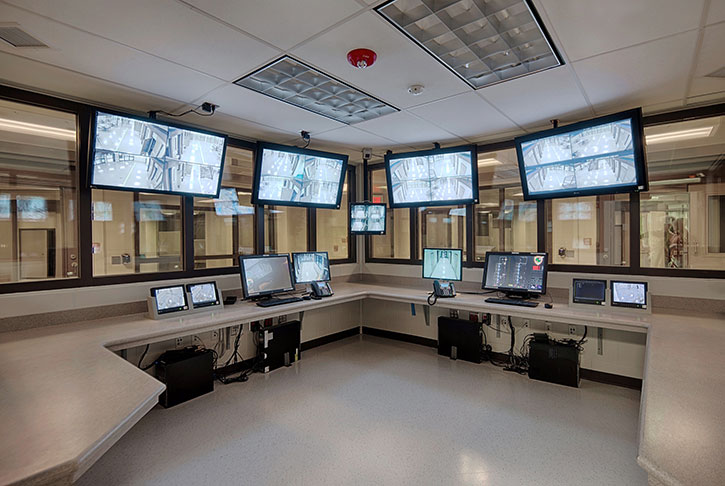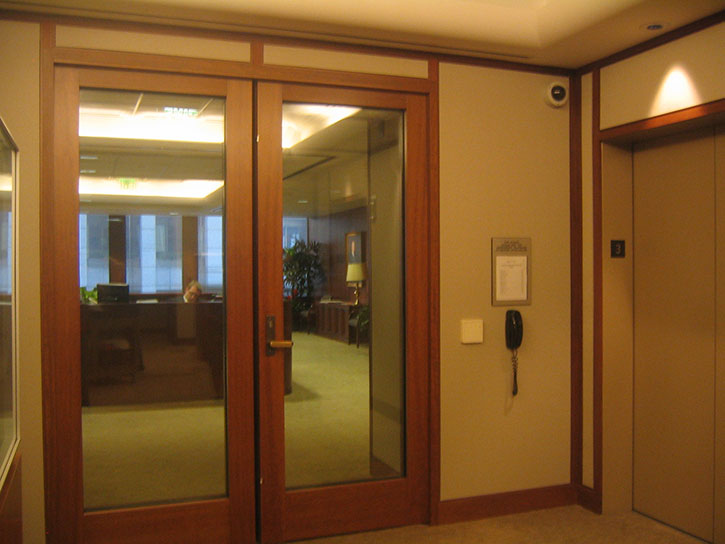Designing Open and Secure Buildings

Designing Open and Secure Buildings
Designing Open and Secure Buildings. This article offers information about security glazing test standards and fire rated, secure glass and framing that resists fire, bullets, forced entry and blast.
It’s an unfortunate sign of the times. Increasingly, architects need to incorporate measures to deter, delay and protect people and property from human aggressors. Their challenge is to find ways to balance security measures with other design constraints such as fire protection, energy efficiency, and aesthetics in order to build inviting, safe environments. New glazing and framing systems offer helpful, attractive tools that can meet security, fire protection and energy efficiency needs all at the same time.Adding glass enhances a sense of openness and improves energy efficiency, but windows and entryways can be the most vulnerable portion of a building. Newly developed, fire-rated glazing assemblies can resolve the dilemma by providing clear, transparent openings and walls that resist forced entry, bullets and blasts while meeting fire and other safety codes.
Fortification of buildings once appealed largely to the State Department, the DoD and prisons, but that is no longer the case. Today, interest in built-in security has expanded to schools, local government facilities, courthouses, storefronts, airports, and homes.
A Short History on Security Glazing Test Standards
Security glazing is not yet mandated by the model building codes. Instead, there is a tapestry of security glazing test standards that have evolved over time. The first test method for bomb blast was ASTM F 1642 published in 1966.
Ten years later, the American Architectural Manufacturers Association published the AAMA 510-06 Voluntary Guide Specification for Blast Hazard Mitigation for Fenestration Systems, which has provided guidance for development of embassies and other State Department properties overseas.
State corrections agencies have developed their own security glazing test standards. For example, the California Department of Corrections and Rehabilitation developed CDCR 860 in the 1980s to test glazing assemblies for their ability to resist forced entry.
The federal government began to take an active role in developing test methods and specifications following the 1995 Oklahoma City bombing of a federal building which killed 168 and injured many more. The Department of Justice assessed the vulnerability of federal facilities. Its study led to creation of an Interagency Security Committee (ISC) a permanent body that helps implement uniform construction standards. Early work by the GSA in creating a performance-based standard for security glazing led to the ISA Security Design Criteria adopted in 2001.
Categories of Security Glazing Test Standards
Glazing products fall into three basic categories of security test standards: forced entry, ballistic, and blast. Here is a list of security test standards that help determine which glazing assembly is appropriate for an application.
• Resists Forced Entry
- ASTM F 1233. Tests for blunt impacts, sharp impacts, thermal attacks, and chemical attacks, and assesses impact types from Level 1-5.
- ASTM F 1592, Framing Test for physical attacks in corrections facilities (does not include high power rifles, explosives, sawing, etc.)
- ASTM F 1915, Glazing for Detention Facilities, which grades glazing based on time and a sequence of blunt and sharp impacts
- CDCR 860, Standard for Security Glazing Products, which designates Classes A-E and requires three impact tests: sledge, axe and hammer and torch.
• Resists Bullets
- UL 752, Standard for Bullet Resisting Equipment, Grades glazing to Levels 1-8, and tests a product’s ability to resist bullet penetration and flying glass fragments.
- NIJ 0108.01 Ballistic Resistant Protective Materials Test standard.
• Resists Bombs
- ASTM F 1642 (original – Glazing Systems Subject to Airblast Loadings)
- ASTM F 2248 (3-second Duration Design Load for Blast Resistant Glazing)
- ASTM F 2912-11 (Glazing Systems Subject to Airblast Loadings)
- GSA/ISC TS01-2003, Defines protection Levels 1, 2, 3a, 3b, 4, 5.
- ISO 16933 (Vehicle Bombs, Hand carried satchel bombs)
- ISO 16934 (Explosion Resistant Glazing)
New Assemblies Can Do Much More Than Meet Security Tests
Innovations by glazing manufacturers have produced glazing assembly options that not only resist forced entry, bullets, or blasts, but also protect buildings and occupants from fire, radiant heat and impact while providing aesthetic and environmental benefits associated with the use of glass.
In response to growing demand, fire rated glazing manufacturers are providing products that can perform double-duty. The use of a fire-resistive, attack resistant glass and frame assemblies or curtain walls allow designers to add transparency to entryways, exit corridors, exteriors while keeping the building and its occupants safe and secure.
SAFTI FIRST Products Resist Forced Entry, Bullets and Blasts
SAFTI FIRST is a pioneer in the field of security glazing, and has developed a a series of fire and security glazing products that provides maximum fire resistance and maximum security simultaneously. “Designers can also take comfort in knowing that they have a product designed and tested to do the job as required,” explained Tim Nass, VP of National Sales for SAFTIFIRST, “and not a system ‘cobbled’ together with different components.”
Below is a description of SAFTI FIRST’s security glazing products and the fire and security test standards they meet.
Resists Forced Entry
- The only wire-free, fire resistive rated security glazing to meet CDCR 860-14a testing requirements and ASTM F1914 Grades 1-4.
- Available in dramatically large sizes and impressively high STC ratings compared to the antiquated wired glass versions that correction facilities settled for in the past.
- Also meets ASTM E 119 / UL 263 / NFPA 251 with hose stream up to 2 hours for Fire Resistance.
 |
| SuperSecure II-XLS with Level III Ballistic/Grade 2 Attack and one-way reflective glass by SAFTI FIRST for the control rooms at Plaquemines Parish Detention Center in Davant, LA |
Resists Bullets
- 45-120 minute clear, fire resistive, ballistic and attack rated, glass and framing system for walls, openings and doors.
- Meets UL 752 Level 3 and can be customized to meet up to Level 8 for Ballistic Resistance. Meets ASTM F 1592 Grade 1 for Attack Resistance.
- Meets ASTM E 119 / UL 263 / NFPA 251 with hose stream up to 2 hours for Fire Resistance.
 |
| GPX Ballistic pair doors with cherry wood veneer by SAFTI FIRST at the private office in San Francisco |
Resists Bombs/Blasts
- 45-120 minute clear, fire resistive, blast rated, glass and framing system for walls and openings.
- Designed in accordance with ASTM F2248 Standard Practice for 3-second duration design loading for blast resistant glazing. Can be engineered to meet all levels of blast protection.
- Meets ASTM E 119 / UL 263 / NFPA 251 with hose stream up to 2 hours for Fire Resistance.
 |
| One of the many GPX Blast exterior wall openings by SAFTI FIRST at the VA Primary Care Annex in Tampa |
Click here to download a brochure on these new security products. Click here to see recent installations of all our products.